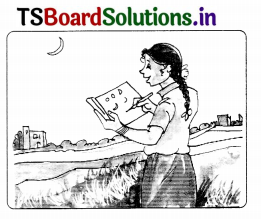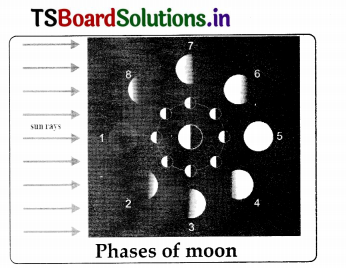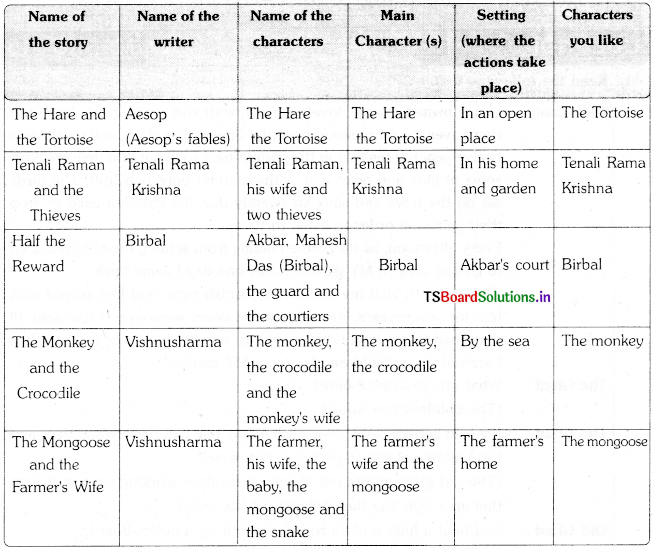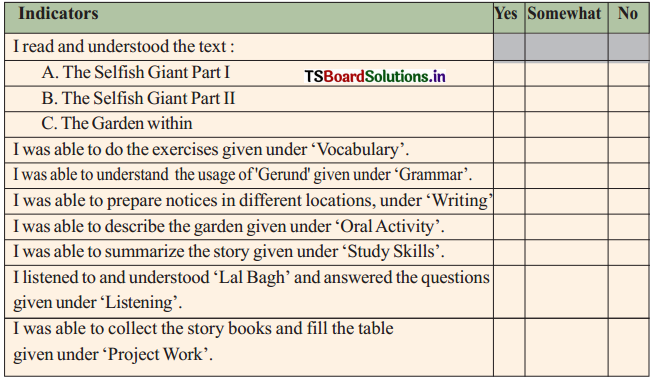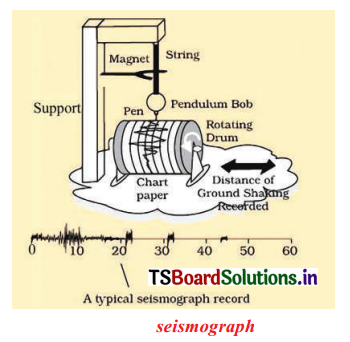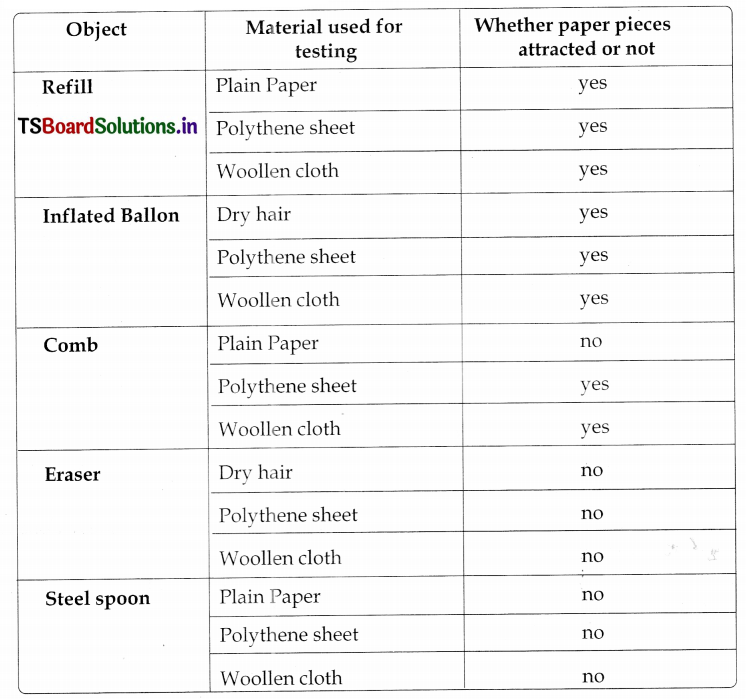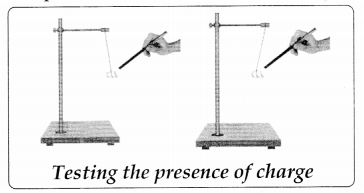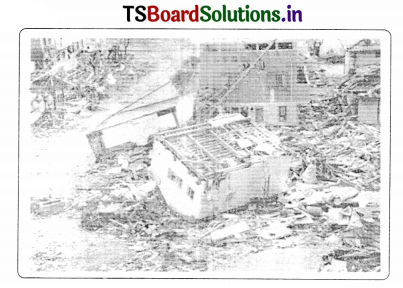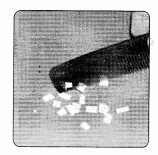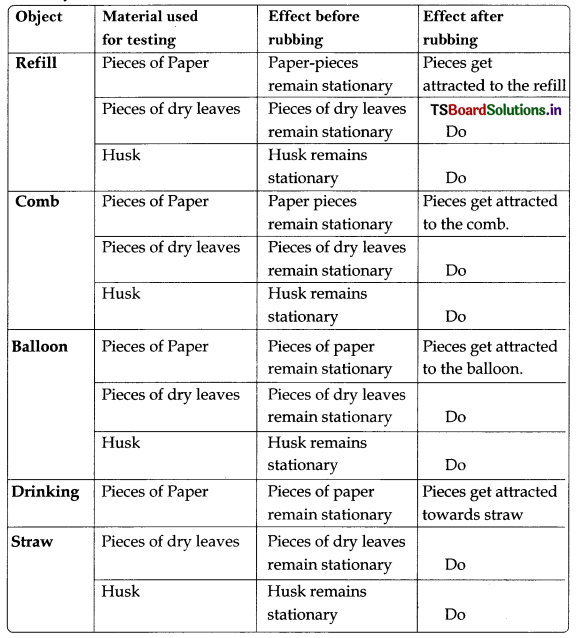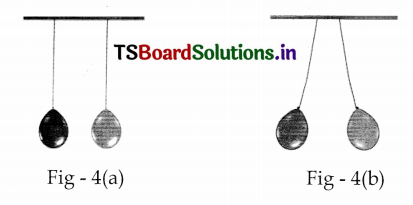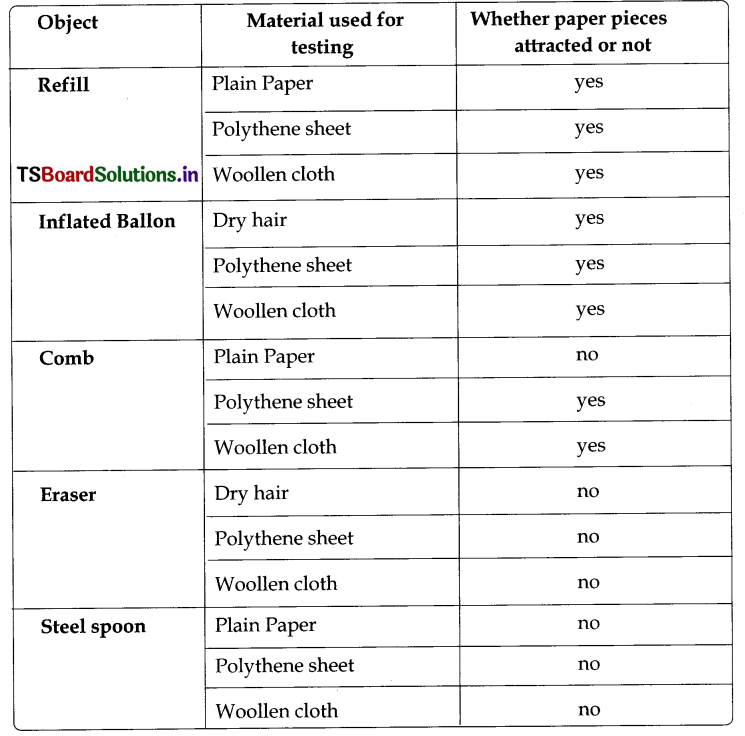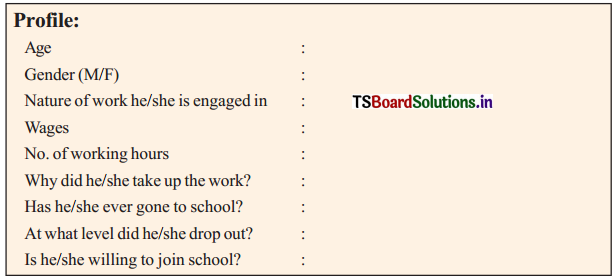Telangana SCERT 8th Class English Study Material Telangana Unit 5B The Treasure Within (Part II) Textbook Questions and Answers.
TS 8th Class English Guide Unit 5B The Treasure Within (Part II)
Comprehension:
The Treasure Within – I:
Answer the following questions.
Question 1.
What nightmare did Hafeez hove?
Answer:
Hafeez had nightmares about educational matters. Particularly, mathematics was a terrible nightmare to him. He used to get continuous nightmares about appearing for a mathematics examination of which he knew nothing.
Question 2.
Which words of the principal influenced Hafeez deeply?
Answer: One day the principal called Hafeez and told him that he had been observing from day one. He was a good student, but he never studied. He had taken care of Hafeez till that day. He could no longer take care of him. Hafeez had to do it himself.
The principal further said, ’You don’t have your father, your mother has worked so hard to bring you up and paid all your fees all these years but you have only played games. Now you should rise to the occasion and study.” These words of the principal influenced Hafeez deeply.
![]()
Question 3.
“…. That year I did not step out onto the field.” Who said these words and why?
Answer:
Hafeez Contractor said these words. He was a very good sportsman. He had been the senior champion for so many years and he also was the cricket captain. He used to play every game. But when the principal spoke to him he realized that he should study. In that context, he said these words.
Question 4.
What was the reason for which Hafeez indulged in distraction?
Answer:
Hafeez was just interested in playing and nothing else. He was most interested in funny pranks. Whenever he did not want to study, he created a distraction.
Question 5.
What things did Hafeez prefer to academic? List them.
Answer:
Hafeez was interested in sports. He had been a senior champion for so many years. He was the cricket captain also. He used to play every game.
He was also interested in funny pranks. Every Saturday he used to see a movie along with his friends. He used to be the leader of his gang. They had gang fights also. They planned strategies. Hafeez preferred these things to academics.
![]()
The Treasure Within – II:
Question 1.
Why couldn’t Hafeez join either the police or the army?
Answer:
Hafeez wanted to join the army. He got his admission letter but his aunt tore it up. Then he decided to join the police force. But his mother asked him to do graduation instead of joining the police force.
Question 2.
What made Hafeez become an architect?
Answer:
Hafeez went to an architect’s office to learn French. His French teacher was his cousin, the architect’s wife. Once he observed a person drawing a window there. Hafeez found fault with the picture of the window. It was true. There was something wrong. The architect and the husband of Hafeez’s cousin was surprised and advised him to drop everything and join architecture. Hafeez had an understanding of the structure of how a thing looked like, from the top. He also had a good understanding of the section of a structure, though he didn’t know the name‘section’.
Question 3.
Why did Hafeez’s teacher think that he could become an architect?
Answer:
Hafeez’s teacher, Mrs. Gupta, saw his sketches and told him that he was useless in everything else. But she praised his sketches and said that he would grow up and become an architect.
![]()
Question 4.
Why do you think Hafeez was not interested in studies ?
Answer:
Hafeez was imaginative and always wanted to do things. These are his creative abilities which don’t find place in his studies. So, Hafeez was not interested in his studies.
Question 5.
Comment on the statement “giftedness and learning disabilities go hand In hand”. How do Hafeez’s experiences support this statement?
Answer:
If one person is disabled in one area, he might have remarkable abilities in other area. Hafeez , was not good at languages and mathematics. But he was good at drawing sketches and other creative* activities like making buttons using chalk and blade. He grew up and finally became an architect. So we can say that giftedness and learning disabilities go hand in hand.
Question 6.
What, according to Hafeez, is “mathematics”? Do you agree with his view of mathematics? Give reasons.
Answer:
According to Hafeez, putting design, construction, psychology and sociology together and making a sketch from all that is ‘mathematics’. Originally he hated mathematics that is bookish. He took the parts of mathematics that were needed to him in his profession. He loved that mathematics he understood and used. I completely agree with his opinion.
![]()
Vocabulary:
I. Read the following sentence taken from the text.
‘I used to get continuous nightmares about appearing for a maths examination’.
The word ‘nightmare’ mean’s a frightening dream.
Now, read the following sentences and find the appropriate meanings of the words underlined.
- Varun is interested in archeology.
- I was so much absorbed in the match that I didn’t notice the thief come in.
- The students listened raptly to the lecture.
- The mysterious story engrossed the readers all the way to the surprise ending.
- Her painting never fails to fascinate the viewers.
Now, observe the following table and put a tick (✓) in the grid where the element of meaning relates to the particular words according to the sentences given before.

Answer:
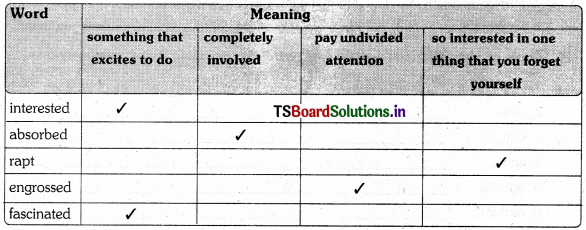
![]()
II. Look at the following sentence taken from the text.
“I used to have this terrible nightmare.”
The word ‘terrible’ intensifies the meaning of the word ‘nightmare’ in a negative sense.
Can we say ‘terrible flower’ or ‘terrible success’? We cannot, because flower and success are pleasant things.
A. Write a few words that can go with the word ‘terrible’ and use them in your own sentences. One is done for you.
Ex:- 1. terrible experience : We had a terrible experience when we met with an accident.
Answers:
- terrible experience : We had a terrible experience when we met with an accident
- errible creature : Shark is a terrible creature.
- terrible smell : There is terrible smell coming from that room; a rat must have died.
- terrible situation : The orphans don’t have food to eat and water to drink. This is a terrible situation.
- terrible pain : Yesterday the operation was over. But the patient is suffering from a terrible pain.
- terrible music : This film has terrible music.
- terrible headache : Today she has a terrible headache.
- terrible English : I cannot understand his terrible English.
- terrible accident : He met with a terrible accident.
- terrible news : Yesterday I received some terrible news from my friend.
B. Look at the following words and write the possible word combinations.

Answers:
- ugly : ugly face, ugly rumour, ugly shot
- sweet : sweet memories, sweet smile, sweet biscuits
- difficult : difficult problem, difficult situation, difficult job
- funny : funny story, funny appearance, funny film
- horrible : horrible man, horrible murder, horrible speech
- ordinary : ordinary creature, ordinary speed, ordinary performance.

C. Use the above combinations in your own sentences and write them in your notebook.
Answers:
Ugly :
- Latha has an ugly face.
- She spreads ugly rumours.
- Shekhar missed the bird. It was an ugly shot.
Sweet :
- Many people have sweet memories.
- I was attracted to her because of her sweet smile.
- She gave me some sweet biscuits.
Difficult :
- He can solve any difficult problem in mathematics.
- He lost his property and his father. He has been in a difficult situation.
- Marketing is a difficult job.
Funny :
- Sita told Gita a funny story.
- She has some funny appearance.
- ‘Sudigadu’ is a funny film.
Horrible :
- Gopi is a horrible man.
- I have seen a horrible murder.
- I could not listen to his horrible speech.
Ordinary :
- Dinosaur is not an ordinary creature.
- He drove his car at ordinary speed.
- His ordinary performance in exams depressed his parents.
![]()
III. Look at the following word taken from the text.
“board”
Does the word ‘board’ have only one meaning or more than one meaning?
Let us now understand the different meanings of ‘board’
a ‘board’ as a noun can be:
- a piece of wood
- a group of decision-making people in an organisation/institution
- an organisation
- the stage in theatre
- meeds provided during the stay in a hotel.
Similarly, the same word ‘board’ can have the following meanings when it acts as a verb.
- to get on plane/ship, etc.
- to pay to eat meals and sleep in someone’s house
- to arrange for a pet animal temporarily.
A. Read the following paragraph carefully. Write the different meanings of the word ‘present’ in the space provided.
Last Sunday, I attended Lahari’s birthday party. All her family members and friends were present (1) there. In the beginning of the party, Lahari’s father presented (2) Ms.Mrunalini Guptha, the world number one Kathak artist at present(3). Ms. Guptha did present (4) a scintillating show. I enjoyed the party a lot. At the end, I gave Lahari a marvellous present (5).
Answer:
- attended (the party)
- introduced
- now
- performed
- gift
B. Pick out similar words from the text or elsewhere, that can be used as both a noun and a verb. Look them up in a dictionary and write their different meanings.
Answers:
field : a) We found fields (n) with ripe corn on either side of the road.
b) The fielder (n) from the third man boundary fielded (v) the ball well
change : The change (n) in the climate changed (v) prospects of the farmers.
influence : Vivekananda influenced (v) the thinking of youth. His influence (n) is felt even now.
surprise : She surprised (v) us by getting distinction in the examination. Another surprise (n) is that she won a lottery.
draw : The match was a draw(n). But the team drew (v) flak from the spectators.
design : We wanted a design (n) for a factory. But the architect warehouse.
![]()
Grammar:
I. In the interview, Hafeez Contractor shares his past experiences and habits by saying.
“I used to be so interested in playing. 1 would receive caning every week.”
Both ‘used to’ and ‘would’ are used to talk about habitual actions of the past.
A. Pick out some more similar expressions from the text having “used to” and “would” and write in your notebook.
Answers:
Hafeez used to play during school.
I would forget after two days.
We used to have competitions.
I used to have this terrible nightmare.
I would think of flowing water.
I used to get continuous nightmares.
I would be thinking about the flowing water.
I used to be interested in games.
They would come running.
I used to be a very good sportsman.
I would cut a button.
I used to play every game.
The student would get past dinner.
I normally used to copy and pass.
I would copy in class.
I used to be so interested in playing.
I would try to get hold of the examination paper.
I used to be the leader of the gang.
I would go for prayer.
These things used to interest me.
I would receive caning every week.
Students used to book my textbooks.
They would cane you.
It would hurt badly.
So what I would do was have no lunch
I would eat to my heart’s content.
We would have gang fights.
Nobody would stop you from doing what you needed to do.
Detailed Information on ‘Used to’
Use verb (1) after used to.
Example :
I used to go to the beach every day.
Note : It is better not to use ‘used to’ in questions or negative forms; however, this is sometimes done in informal spoken English. It is better to ask questions and create negative sentences using the Simple Past.
![]()
Use of ‘used to’
(a) To express a habit in the past : ‘Used to’ expresses the ideas that something was an old habit that stopped in the past. It indicates that something was often repeated in the past, but it is not usually done now. .
Examples :
Hari used to study English.
They used to go to their native village in summer.
I used to start work at 9 o’ clock.
She used to eat meat, but now she is a vegetarian.
(b) To express past facts and generalizations: ‘Used to’ can also be used to talk about past facts or generalizations which are no longer true.
Examples :
I used to live in Delhi.
Sruthi used to be fat, but now she is thin.
Manjula used to be the best student in class, but now Sindhu is the best.
Oranges used to cost very little in Nellore, but now they are quite expensive.
Used to vs Simple Past:
Both Simple Past and ‘used to’ can be used to describe past habits, past facts and past generalizations; however, ‘used to’ is preferred when emphasizing these forms of past repetition in positive sentence. On the other hand, when asking questions of making negative sentences, Simple Past is preferred.
Examples :
You used to play the piano.
Did you play the piano when you were young?
You did not play the piano when you were young.
‘Used to’ in Passive Voice:
Swathi used to pay the bills. (Active Voice)
The bills used to be paid by Swathi. (Passive Voice).
Detailed information on ‘Would’
would for unreal situations
The word would is used for unreal or imagined situations:
I would love to visit New York.’
‘She would like to be professional footballer.’
We would go, but we are too busy.’
would as a past tense:
would and wouldn’t are the past tense of will and won’t. Let’s look at an example of this using direct and reported speech:
Andrew : ‘I will be late.’ (direct speech)
Andrew said that he would be late, (reported speech)
would in conditional sentences
Would is used again for unreal or hypothetical situations in the 2nd and 3rd conditionals:
2nd Conditional : ‘If I won the lottery, I would travel the world.’
3rd Conditional : ‘If I had worked harder, I would have passed the test.’
would not as ‘to refuse’
Wouldn’t (would not) is used to show that someone refused to do something:
I asked him if I could borrow his car, but he wouldn’t lend it to me.’
would for past actions
Would can be used to talk about actions that repeated in the past. It is used in the same context as used to:
‘When I was young I would do my homework every evening.’
‘In the summer we would always go camping.’
B. Tell your friends what you did normally when you were in class VII.
Answer:
- I used to attend the classes regularly.
- I would play with my friends in the evening.
- One of my friends used to like mathematics in the class. –
- And, I used to like sciences and English.
- Finally, I got good marks and got admission in a prestigious government college.
![]()
Writing:
In the interview, you have read about Hafeez Contractor’s school experiences and career development. Now, imagine that Hafeez Contractor has been invited as the Chief Guest, as a part of the Children’s Day. Prepare a script for compering the programme. Make a mock presentation in the class.
Hafeez Contractor was born in 1950. He did his Graduate Diploma in architecture from Mumbai in 1975 and completed his graduation from Columbia University, New York (USA) on a Tata Scholarship. Hafeez Contractor commenced his career with T. Khareghat as an apprentice architect and in 1977 he became the associate partner in the same firm. Between 1977 and 1980 Hafeez was a visiting faculty at the Academy of Architecture, Mumbai. He is a member of the Bombay Heritage Committee and New Delhi Lutyens Bunglow Zone Review Committee.
Contractor’s practice had modest beginnings in 1982 with a staff of two. Today the firm has over 350 employees including senior associates, architects, interior designers, draftsmen, a civil engineering team and architectural support staff. The firm has conceptualised, designed and executed a wide range of architectural projects like bungalows, residential developments, hospitals, hotels, corporate offices, banking and financial institutions,’ recreational and sports facilities, townships, airports, railway stations, urban planning and civic redevelopment projects.
Follow the features of a compering given below.
- Arrange the programme as required by the context.
- Present the background.
- Highlight the persons and events.
- Give reviews and reflection relevant to the context.
- Use polite and entertaining expressions.
- Follow the conventions of the stage.
Answer:
Good evening, we gathered here to celebrate the Children’s Day which is observed in commemoration of the birthday of Pandit Jawaharlal Nehru, the former Prime Minister of India.
On this occasion, we have the distinguished guests who, kindly accepted to grace the occasion. It gives us immense pleasure to have an eminent architect, Mr. Hafeez Contractor, with us as the chief guest.
Now we’ll begin the programme.
First of all, I’d like to welcome Sri Narasimha Rao, The Head Master of the school. Please give him a big hand.
Next, on behalf of the school committee, it’s my privilege to invite Mrs. Nagamani, Tahsildar of the Mandal, who consented to be the special guest of the day.
It is a fact that since she assumed charge in the Mandal, every activity in her department has assumed a new pace. Also, she won the government award on the occasion of Republic Day this year, which is a prestige to the people of the Mandal.
And now, we have a noted architect, he is known for his imagination, meticulous planning and careful execution. To his clients, he is everything. Whenever there is a problem the clients turn to their architect. Having completed his graduate Diploma in architecture from Columbia University, New York, he began his career as an apprentice architect in 1977 and came out in flying colours. Now he is a member of Bombay Heritage Committee and New Delhi Lutyens Bunglow Zone Review Committee.
Now, may I please sir, invite you on to the dais, to share your experience with us on this momentous occasion. A big hand to Mr. Hafeez Contractor, a prodigy in architecture, please. I request Mrs. Nagamani to greet Mr. Hafeez with a bouquet.
Now I request the HM of the school to be the chair of the occasion and run the proceedings.
![]()
Listening:
Listen to a compering script prepared by a student on the occasion of the Teacher’s Day celebrations and answer the following questions.
Compering
Respected MEO, our beloved headmaster, dear teachers and my fellow students,
I wish you a very good morning and welcome you to the programme.
At the outset, I wish all the teachers a very happy Teacher’s Day.
As we all know that 5th September is celebrated as Teacher’s Day as a mark of our tributes to the contributions made by teachers to the society. It is also celebrated to commemorate the birth of Dr. Sarvepalli Radhakrishnan, A great educationist and former President of India.
Let us now start the programme with a prayer.
I invite Kamala and Vimala to offer the prayer.
Thank you, Kamala and Vimala for your wonderful prayer. To move to the next item of the programme, it is a moment of pride and honour for us to have our Mandal Educational Officer, who is an eminent scholar as the chief guest. Now I request him to come onto the dais and grace the occasion.
Next, I would like to invite our headmaster who is an inspiring personality to grace the occasion. I also request him to present a bouquet to our Chief Guest.
Now, I request our MEO to say a few words on the occasion.
Thank you very much sir, for giving your inspiring words to us.
Now, you will watch a skit.
I’m sure you have liked the skit… once again, let us give them a big round of applause. The next item is a group dance. It will be presented by Latha and her group from class IX. Hope you will enjoy it.
Wow! Fantastic, it is an excellent performance. Let us once again appreciate them by clapping.
Now, the last item of the programme is Vote of Thanks. I take this opportunity to invite Ms. Aparna to propose a vote of thanks. With that the programme has come to an end. Finally, I invite you all to have refreshments outside the hall. I thank one and all for making the event memorable and enjoyable.
![]()
Answer the following questions.
Question 1.
How did the student begin compering?
Answer:
The student began the compering by addressing the guests, Teachers and students and then she greeted everyone on the occasion of the Teacher’s day.
Question 2.
How did she/he arrange the different events of the programme ?
Answer:
She arranged the programme firstly by greeting the guest, outlining the importance of Teacher’s Day followed by a prayer and then speeches by the guests. Cultural programmes followed and vote of thanks was proposed before the programme concluded.
Question 3.
What were the highlights of the event?
Answer:
The MEO’s speech, a skit and a group dance were the highlights of the event.
Question 4.
How did he/she conclude the programme?
Answer:
She concluded the programme with vote of thanks and she requested everyone to have refreshments outside the hall.
![]()
The Treasure Within (Part-II) Summary in English
The interview between Ms. Bela Raja and Hafeez Contractor continues in this part. This part of the interview makes it clear to us how Hafeez became an architect.
At first, Hafeez got an admission letter to join the Army. But his aunt tore the letter. He then wanted to join the police force. His mother discouraged him and asked him to do graduation. So, he joined Jai Hind College in Bombay. There he had to study either German or French. He had already studied French for seven years but failed to learn even seven words of French. So, he took German. Then his German Teacher died. Without French or German, it was not possible to continue to study in that college. So, he decided to learn French again. He started learning French from his cousin. This was an unexpected turn in his life.
Hafeez’s cousin was an architect’s wife. He had to go to the architect’s office to learn French. There he saw somebody drawing a window details. Hafeez found fault with the drawing. The other person had a bet with Hafeez. Finally, he found that his drawing was wrong. The architect who was his cousin’s husband was surprised at this. He asked Hafeez to draw a few specific things. Hafeez drew them within no time. He asked Hafeez to design a house. Hafeez did that too. He asked Hafeez to drop everything and join architecture.
Then, they went to meet the principal of the college. The principal was convinced with the argument of the architect and consented to give a seat in architecture on a condition. The condition was that Hafeez had to clear an entrance exam as his score in the qualifying examination was just 50%. Hafeez got through the exam with an A+’. From that day it was a cakewalk.
At school, Hafeez was very bad at languages. He was not good in mathematics even. Whatever they learnt today, they would forget in two days. The reason was – there was no application of mind. In the boarding school, life was difficult. Whenever they had tests, i! vy used to copy. But, the teacher had an impression that they learnt the lessons well.
The students who excel in academics may not succeed in real life. On the other side, there are students who were very ordinary in their academics but excelled in their career. Hafeez is an example for the second type of students. Every student will not learn in the same way. Hafeez had imagination that was not encouraged by the school curriculum.
As a successful architect, Hafeez always tries to look at the client’s face, his language, his way of eating and comes to a conclusion about the design the client needs. The set of conditions is nothing but ‘mathematics’ he says. He had his own mathematics, which he now loves very much.
![]()
Glossary:
field (n) : area of work
architecture (n) : the art and study of designing buildings
army (n) : one section of defence force
influence (n) : recommendation
architect (n) : a person who practises architecture
drop (n) : leave
calling (n) : work of his choice
cakewalk (n) : something easy to achieve
section (n) : cutting ; divide into parts
stumbled on (phr.v) : got into (architecture) by chance
offbeat (adj) : unusual
forts (n) : castles
ammunition (n) : supply of bullets
sketches (n) : pictures
cope with (v) : manage
curriculum (n) : syllabus ; the subjects that are included in a course of study
deal with (phr.v) : cope
concept (n) : idea
contention (n) : difference of opinion
ordinary (adj) : normal
come across (phr.v) : meet or find by chance
situation (n) : state or condition
street smarts (n) : skilled and wise people moving in streets
defied (v) : broke
academics (n) : studies
personality (n) : personal qualities
block (v) : stop
hold (v) : stop
client (n) : customer
pronounce (v) : the way one speaks
spontaneously (adv) : without planning
on the spot : then and there
instinctively (adv) : naturally ; without giving much forethought
instinct (n) : an unlearned activity
design (v) : plan
psychology (n) : behavioural science
sociology (n) : study of society
come to a full circle (idm) : return to the same attitude that one originally had
derive (v) : deduce
interpretation (n) : analysis, explanation

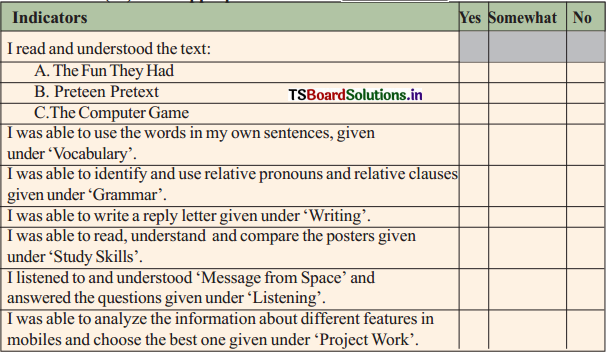




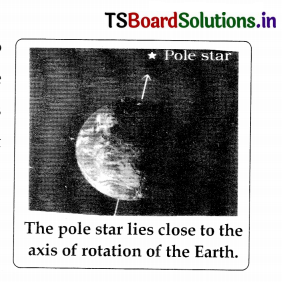


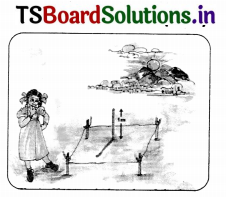
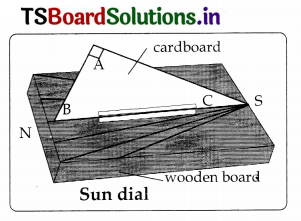


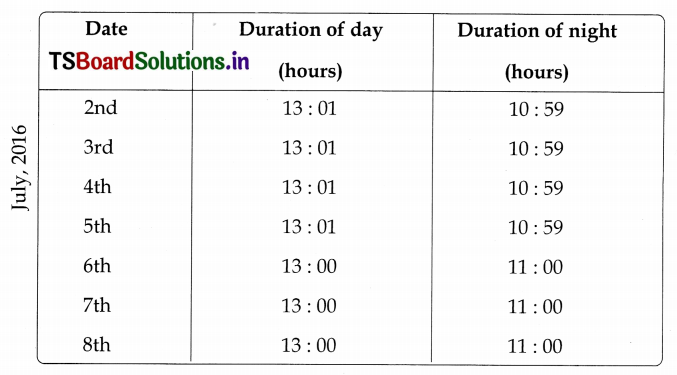 :
:

